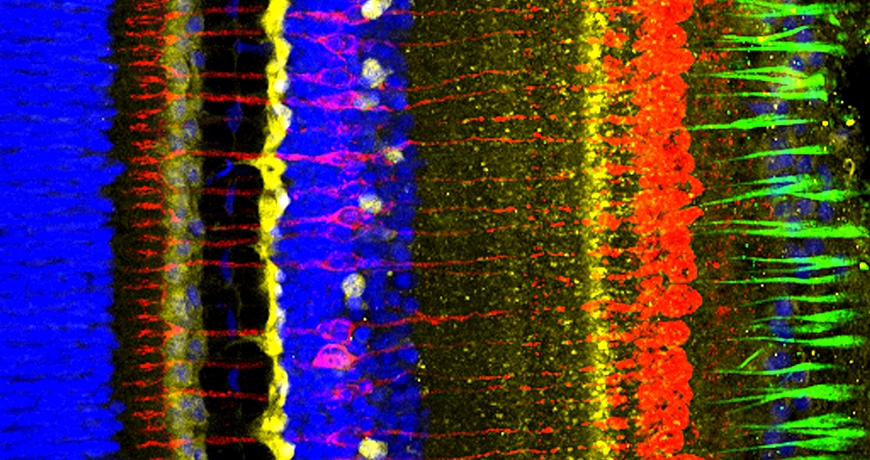Holotomographic microscopy
Spiky insight: How red blood cells deform
Empa researchers have observed living red blood cells transforming into spiky "echinocytes" in real time when treated with high concentrations of ibuprofen using holotomographic microscopy and displayed them in 3D renderings. They recently published their findings in the scientific journal ACS Nanoscience Au.


Blood is indeed "a juice of rarest quality." What the poet and natural scientist Goethe already suspected can now actually be visualized using innovative imaging techniques. One of these special features is the cell that occurs most frequently in the bloodstream: the erythrocyte. Trillions of these red blood cells make their way through the human body every minute. The fact that they do not always take on a round shape enables them to squeeze through the narrowest blood vessels to supply the most remote corners of our body with oxygen.
However, some changes in the shape of erythrocytes are also typical of special changes in the environment: so-called echinocytes with spiny extensions similar to a sea urchin occur, for instance, in the case of burns, liver damage, or after contact with certain drugs. Empa researchers have now observed the transformation of red blood cells into echinocytes using digital holotomographic microscopy.
Talia Bergaglio and Peter Nirmalraj from Empa's Transport at Nanoscale Interfaces laboratory in Dübendorf provoked the deformation of living red blood cells by adding the drug ibuprofen. They were able to show the transformation of roundish donuts into echinocytes in real time thanks to holotomographic microscopy. This innovative technique works similarly to computed tomography (CT), where imaging takes place via laser technology instead of X-rays. Digital holotomographic microscopy is therefore particularly suitable for biological samples such as blood cells, as it enables high-resolution, non-contact and marker-free images to be taken, which can then be reconstructed as three-dimensional representations.
Red blood cells are ideal model cells for this purpose, as they can be easily identified even in whole blood and given their morphology is sensitive to chemical and physical environment, during the course of their existence; they are ultimately (almost) empty membrane shells. "Therefore, the interactions of a variety of drug molecules with the cell membrane can be studied particularly well on red blood cells using our bio-imaging technique," says Empa researcher Nirmalraj.
Transport at Nanoscale Interfaces
Phone +41 58 765 42 61
peter.nirmalraj@empa.ch
Dr. Andrea Six
Communication
Phone +41 58 765 6133
redaktion@empa.ch

Empa Quarterly#81 Battery research
Being able to store energy is a central pillar of a sustainable energy system, since solar and wind energy are not always available in sufficient quantities when they are needed. Good batteries are indispensable for the energy transition, and thus for a more sustainable world. Empa researchers are developing batteries for different applications, from stationary energy storage to electromobility. They are also working on analyzing and recycling end-of-life batteries.
Read the latest EmpaQuarterly online or download the pdf-version.

Empa Quarterly#82 Mining the Atmosphere
To limit climate change, we need to compensate not only for future emissions, but also for historical ones. One solution would be the "atmospheric vacuum cleaner": we remove the excess CO2 from the atmosphere. But what do we do with it? Instead of extracting the carbon for polymers, medicines, fibers, fuels and the like from crude oil, we use atmospheric CO2. This is the simple – yet extremely challenging in technical terms – idea behind Empa's new research initiative, Mining the Atmosphere.
Read the EmpaQuarterly online or download the pdf-version.

Empa Quarterly#83 Perovskites: Versatile cristals
Over 180 years ago, a curious crystal was discovered in the Ural Mountains. Today, it has given rise to an entire class of materials that is of great interest to researchers: perovskites. What all perovskites have in common is their crystal structure, which gives them unusual properties. By changing the exact composition of the perovskite, scientists can control these properties. Empa researchers are using this promising material to develop solar cells, detectors and quantum dots.
Read the EmpaQuarterly online or download the pdf-version.
-
Share

|
Mapping the knee Using 3D models based on micro-CT analyses, Empa researchers are mapping the blood vessels of the meniscus on a nanometer scale to provide an improved basis for clinicians in order to reduce the risks of knee operations. |
|
Showing foresight Heinz A. Oertli founded the company “Oertli Instrumente” and knows how great ideas grow into sustainable start-ups. Now he is supporting innovative projects with a fund as part of Empa’s “Zukunftsfonds”. |









